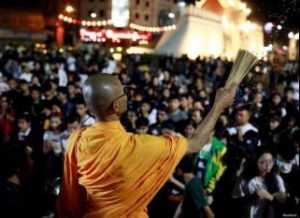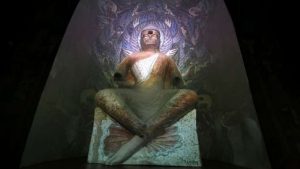
Take down a musical instrument.
Let the beauty we love be what we do.
There are hundreds of ways to kneel and kiss the ground.Rumi*
It’s really too early to share much about the two-month retreat I have just been on. It seems wise to allow the effects of these many weeks of intense practice to slowly and quietly percolate through my system and continue to effect change in unforeseeable and mysterious ways. But there is also something to be said about making the most of the freshness of some of the turning points and insights by putting them into words, however approximate they may be to the actual experience.
I am also curious about re-engaging with writing at my computer: maybe sitting in front of the screen and using the keyboard will feel a bit different; maybe I won’t cross my legs so much, cross out so many phrases in self-critical ways, keep my shoulders down and my heart open. Maybe it could feel like making art, or playing music, or dancing, with that readiness to take delight in an unfolding that is a little out of my control.
To set the scene: there are 34 of us, all members of the Triratna Buddhist Order, at a hotel on the Gower Peninsula in Wales, UK, which has become a pop-up retreat center. Bright thangkas of buddhas and bodhisattvas hide television screens, and there are photos of famous Buddhist teachers alongside heavily framed oil paintings of previous inhabitants of this former hunting lodge. Mahogany, richly textured wallpaper, and bright chandeliers go quite well with the colorful shrine that takes up most of one wall of the hotel dining room. Tall windows open onto an extensive, quiet, park-like landscape, and the sea is a 20-minute walk away. There is an emerging rhythm of a few days’ teaching by Vessantara, our main leader, followed by 5–7 days of silent practice. We have 15-minute meditation reviews with a member of the team twice a week, otherwise we are in silence. We have each memorized our timetable: those meditation reviews, then once-a-week cooking duty, cleaning, and some of us go to taught qigong or Iyengar Yoga sessions. I do my own eclectic movement practice in several daily half-hour spurts, before or after meditation. I am working on opening the upper spine and chest, as my posture has become quite hunched by decades of work at the computer. There is a large, airy conservatory reserved for bodywork, and we see all kinds, from puffing and panting military-style workouts to meditative, reclining Yin Yoga, to astounding acrobatics. The glass ceiling of the conservatory, from which a rainforest of artificial plant greenery trails down, connects us with the weather—some exhilarating clear blue skies; mostly clouds and rain. The shared silence on the retreat builds and builds; stepping into the shrine room feels like being engulfed in a warm bath of kindly presence.
We are exploring a text by the Ninth Karmapa, Eliminating the Darkness of Unawareness, which is, like all Mahamudra texts, about understanding—in a direct, experiential way—the non-dual nature of the mind. The main practice is “just sitting,” and it is an intuitive process of letting go of the ego-based habit of appropriating experience.
About two-thirds of our way into the retreat, Vessantara says something that tangibly shifts things for me. He talks about us tending to “try too hard” in meditation, and encourages us to be alert in more subtle ways, making small, intuitive adjustments is response to the body-mind as if we were playing an exquisite stringed musical instrument. We can become curious about the constantly changing interplay of thoughts, feelings, and body sensations, without any pushing and pulling toward results. Even the term “curious” is not quite fitting though, as it can imply a searching for something and carries too much “selfing” energy. It’s more like playing with the organism, with life as it flows through us in the moment, applying the light and sensitive touch of a skilled musician. The famous lines by Rumi about this sprang to mind when he talked about this:
Today, like every other day, we wake up empty and frightened. Don’t open the door to the study and begin reading. Take down a musical instrument. Let the beauty we love be what we do. There are hundreds of ways to kneel and kiss the ground.
(Still Water Mindfulness Practice Center)
I drop into a deeper layer of confidence, acknowledging that I have lots of experience playing music, painting, and dancing, and feel at home in that realm of intuitive, creative, and subtle responsiveness. I know how to let myself be seduced into self-forgetting by responding to beauty from a loving, open heart—that sense of aesthetic enchantment is familiar to me. It helps “me” relax more deeply and lets these Dharma teachings on the ungraspable nature of awareness and appearances reveal themselves. And it’s probably better not to say any more at this stage. I just want to express some encouragement to readers, to let your own sense of aesthetic appreciation be the leading edge in meditation, rather than a drivenness to achieve results.
What is required can be summarized by Three “A”s: Acknowledge, Allow, and Appreciate. We are probably quite familiar with the first two, recognizing an experience, whether painful, pleasant, or neutral, and doing our best to accept it. Going a step further and appreciating it taps into this “inner artist” part of us that can attune itself to the creative possibilities inherent in the experience. Imagery works really well here—for example, at the beginning of a meditation, when we connect with body and posture, letting the earth absorb any physical or emotional discomfort we carry, not to just to be relieved of it, but as welcome fertilizer. And just like a treasured musical instrument needs to be taken care of, to be polished and kept safe, it helps to eat nutritious food, to regularly engage in exercise we actually enjoy, and to guard the doors of our senses, deciding carefully to what we expose ourselves. Since being home, my husband—who also attended the retreat—and I have decided to make a few changes to our ways of life in order to enhance the chances of staying connected with that flavor of inner freedom. I am particularly excited to be regularly spending time together quietly listening to music—not talking shop, not revising the day or making plans, but just opening our heart-mind to that mystery of lived experience, beyond words.
* From Barks, Coleman, ed. 2005. The Book of Love: Poems of Ecstasy and Longing. London: HarperOne
See more
Letting The Beauty We Love Be What We Do (Still Water Mindfulness Practice Center)
Related features from BDG
Having a Voice During Silence on Retreat
The Joy of Renunciation – In Retreat and in Everyday Life
Silence
Moonbeams of Mahāmudrā: Perspectives on a New Translation by Elizabeth Callahan
Geshe Tenzin Namdak: Living in a Material World
Not Knowing
Duality, Dharma, and the Brain












